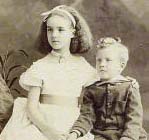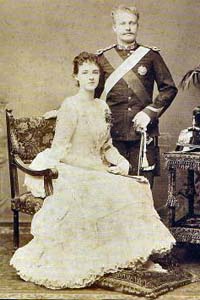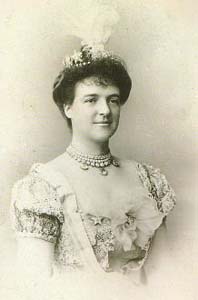Regina

Regina was born in 1978, in Portugal. She has been a royalty fan since forever. Regina has a degree in economics and a master's in Christian studies, and she is presently working as an accountant. Regina has a large collection of memo books and day planners, and is interested in alternative medicine, but flowers are her passion. Her next project will be a short course in floriography (language of flowers).
View all articles by ReginaThe Last Queen of Portugal
Childhood
 Amelia had three brothers and two sisters. Two of her brothers, Charles Philippe and Jacques, died in infancy. Princess Amelia, who considered herself a second mother to her little siblings, was very shaken by these deaths. But with the birth of her little sister Louise in 1882, new joy was brought into the family. The relationship between Amelia and her father was close, and they shared a love of horses and nature. Her relationship with her mother could be tense. More than once, Princess Isabelle slapped her daughter in front of others when she thought Amelia's answers weren't polite enough. Amelia learned a very valuable lesson from her mother's treatment of her, and many years later she treated her own children with the love and compassion that she did not receive as a child. Considering this difficult relationship, it is not surprising that little Amelia adored spending vacations in Spain with her beloved maternal grandfather, the Duke of Montpensier.
Amelia had three brothers and two sisters. Two of her brothers, Charles Philippe and Jacques, died in infancy. Princess Amelia, who considered herself a second mother to her little siblings, was very shaken by these deaths. But with the birth of her little sister Louise in 1882, new joy was brought into the family. The relationship between Amelia and her father was close, and they shared a love of horses and nature. Her relationship with her mother could be tense. More than once, Princess Isabelle slapped her daughter in front of others when she thought Amelia's answers weren't polite enough. Amelia learned a very valuable lesson from her mother's treatment of her, and many years later she treated her own children with the love and compassion that she did not receive as a child. Considering this difficult relationship, it is not surprising that little Amelia adored spending vacations in Spain with her beloved maternal grandfather, the Duke of Montpensier. In 1884 during a tour of Europe, Amelia and her family visited King Alfonso XII of Spain, Amelia's uncle. This visit was a milestone in the princess' social life, and the foreign press praised her beauty and her elegance. But Amelia's social debut came later in the tour, during her visit to Vienna. Archduchess Marie Valerie, the youngest daughter of Emperor Franz Joseph, invited her to go to a play, where she was sitting in the imperial box at the theater. Amelia accepted the invitation, not knowing that she would meet the Emperor face to face in the box. The Emperor invited her to sit at his side, which caused amazement all over the theatre; the entire audience looked at the shy and embarrassed Princess. The princess visited the Belvedere, walked on the Prater and was delighted with all the novelties. After Vienna she ended her trip in Munich where she met a Bavarian prince who would propose to her a few months later. His proposal was refused; the memories of the French-German war of 1870 were still too fresh.
Wedding and Early Married Life
 The Princess said a heartfelt goodbye to everybody who lived and worked in her parents' home in Paris, and more than 10,000 citizens were present to wave goodbye at the railway station where she departed for her new home. On 19 May 1886 she arrived in Portugal at the train station of Vimieiro. Here she changed into a dress made of blue and white silk and a hat in the colours of the monarchist Portuguese flag. Amelia was not an extraordinary beauty, but her impressive height (5 feet 10 inches/180 cm), her dark hair, and her brown eyes impressed the Portuguese spectators. From the station the Princess and her party went to the Palace of Necessidades in Lisbon. On her wedding eve, Amelia visited the palace chapel to confess and to pray.
The Princess said a heartfelt goodbye to everybody who lived and worked in her parents' home in Paris, and more than 10,000 citizens were present to wave goodbye at the railway station where she departed for her new home. On 19 May 1886 she arrived in Portugal at the train station of Vimieiro. Here she changed into a dress made of blue and white silk and a hat in the colours of the monarchist Portuguese flag. Amelia was not an extraordinary beauty, but her impressive height (5 feet 10 inches/180 cm), her dark hair, and her brown eyes impressed the Portuguese spectators. From the station the Princess and her party went to the Palace of Necessidades in Lisbon. On her wedding eve, Amelia visited the palace chapel to confess and to pray.
The royal wedding was celebrated three days after her arrival, on 22 May, in the Church of São Domingos in Lisbon. The day was splendid, the Sun shone, and everyone was on the street to greet the royal family. It was jokingly said that only the sick and the lame stayed at home. On that day, everybody forgot the political differences. In Lisbon, the hotels were filled with guests who came from remote places in Portugal. The church was dazzling, not only because of the blue and white decorations but also because of the beauty and variety of uniforms and gowns worn by the guests. At 2.10 pm the bride arrived at the church with her father. The Countess of Paris followed them and was escorted to the altar by the bridegroom, while the music of Hino da Carta - national anthem of the kingdom of Portugal - was played. Everybody was eager to see Amelia’s dress. She didn’t disappoint them: her white wedding dress was made of faille silk with a long train, and her lace veil was a gift from friends from France. On her head she wore a garland of orange blossom; she didn’t wear any jewelry.
After a short honeymoon in the bucolic and romantic city of Sintra, the young couple went to live in the Palace of Belém while Amelia's parents stayed in the Palace of Necessidades. It was at this time that the family heard that they were exiled from France again. The exile was caused by the “extravagant” celebrations for Amelia's wedding, which had aroused royalist feelings in France.
The first years of their marriage were happy. When the Duchess of Luynes, a friend of Amelia, wanted to know if the Crown Princess had found real happiness, Amelia replied in a letter: "I have adapted very well to my new life; my parents in law are so tender to me and the people show me such kindness.” In 1886, Amelia became pregnant with her first child. It was an easy and happy pregnancy, but the actual delivery of Infante Crown Prince Luís Filipe on 21 March 1887 did not go as swiftly. It took so long that the family and the courtiers got frightened.
From the beginning of her life in Portugal, Amelia refused to be confined to a comfortable life in the palace and started her own initiatives. She didn’t want to limit herself to being a mere financial supporter of social institutions; she visited the institutions and interacted with the people there. But her social activity was not always positively welcomed. Many aristocratic ladies thought it was inappropriate for a royal to visit poor neighbourhoods and spend time with the poor, the sick, and the rejected. The republican press used to criticize her for her contact with the poor too. However, Amelia did not pay much attention to these negative comments and became the patron and founder of two very important institutions: the Institute Princess Dona Amelia (which had been created to support the workers' social rights) and the National Association against Tuberculosis. Health care would become one of her lifelong interests, and several decades later when she was living in exile she became a volunteer in the Hospitals of Wandsworth and Whitechapel, helping the doctors and nurses take care of wounded soldiers during the First World War. In France, Amelia was an important financial donor to the Red Cross and to new schools and hospitals.
By 1888, the health of King Luis was deteriorating. The doctors decided that the monarch should take some time off and go on a boat trip through Europe. During his absence, Prince Carlos assumed the regency of the country. This gave Amelia a taste of her future role as Queen. The regency was not free of political and personal attacks; newspapers criticized Queen Maria Pia for shopping and visiting her friends all over the European courts while her husband the King was travelling alone and sick. Carlos's love affairs become another source of scandals, while Amelia was accused of being vain and too concerned with French fashion.
Amelia Becomes Queen
 The year 1889 had a happy beginning for Carlos and Amelia; they spent several weeks in Spain, where they both spent their time hunting, one of Carlos's favourite hobbies together with oceanography. This vacation from which Amelia would return pregnant, would be the last carefree time for the couple. King Luis died soon after they returned to Portugal. Amelia thought about her mother-in-law, Queen Maria Pia, and wrote a letter letting her know that she would continue to respect her as queen and as mother. When Amelia became Queen, as soon as the phone service was inaugurated in Portugal, she ordered a special a private line, in the Palace das Necessidades, in order to enjoy private chats with her “mother."
The year 1889 had a happy beginning for Carlos and Amelia; they spent several weeks in Spain, where they both spent their time hunting, one of Carlos's favourite hobbies together with oceanography. This vacation from which Amelia would return pregnant, would be the last carefree time for the couple. King Luis died soon after they returned to Portugal. Amelia thought about her mother-in-law, Queen Maria Pia, and wrote a letter letting her know that she would continue to respect her as queen and as mother. When Amelia became Queen, as soon as the phone service was inaugurated in Portugal, she ordered a special a private line, in the Palace das Necessidades, in order to enjoy private chats with her “mother."
Less than a month after the death of King Luis, Amelia gave birth to her second son, who she named Manuel. On 28 December 1889, Carlos swore his oath his oath and was acclaimed as King Carlos I of Portugal. The first year of his reign began with a death: Amelia’s grandfather, the Duke of Montpensier, passed away. Another death followed 5 years later; this time Amelia's father died. Apart from those deaths, these years were the best years of her life, with her sons were growing up healthy and happily. When the Queen was not in Vila Viçosa, the children used to write her many letters telling her about their progress in hunting. Sometimes they also had to tell her about their misfortunes. Prince Luis Filipe wrote to his mother: "Yesterday I failed to shoot a very wild boar, and you, my Mother, can’t imagine how ridiculed I was by everyone… At dinner, I got a letter from my friends. Father gave it to me. It was a picture of a sad boar, a happy boar, and a third boar looking me in the eyes. This last one said “with all my thanks!” Luis Filipe ends his letter with the dedication “To Your Majesty the Queen, from the Number 1.”
On 2 October 1895, King Carlos started the first foreign official visits of his reign. He tried to strengthen diplomatic relations with the big European powers. His tour started in Spain, followed by visits to France, Germany, and England. The King's visit to England was especially important as relations between the two countries had gone sour. In 1890 Britain had sent an ultimatum to Lisbon, telling Portugal to give up the territories between Angola and Mozambique. This ultimatum was a source of anger for many Portuguese, who were proud of the large Portuguese Empire in Africa, Asia, and Oceania. As Portugal was bankrupt, the country could not afford a war with Britain and the government had no other option than to bow to British demands. King Carlos, however, seemed to enjoy the company of King Edward VII in England, which angered Portuguese monarchists as well as republicans. Many newspapers called the king “Traidor!” - Traitor. During this trip, Queen Amelia stayed in Lisbon and acted as regent, a responsibility she found difficult to combine with her private life. Since Amelia was both Queen and acting Head of State, protocol rarely allowed her the luxury of being alone.
However, throughout her life, Amelia set aside some solitary time with her diary, where she could write about her state of mind and other emotions. But only horses and the sea gave her the rare moments of individual freedom. Her husband's interests and hobbies were in the arts and sciences, especially oceanography. The merit of his works in this area, namely his extensive book collection and scientific studies, was (and still is) internationally recognized by the most important scientific institutions. The King was also a painter. His watercolours of Portuguese landscape, boats, and the sea are his best personal art legacy, together with drawings of Portuguese birds for a book named Birds of Portugal. Horses were a shared interest of the couple. The Queen had loved to ride ever since childhood, her height and athleticism made her an outstanding rider. The was another interest the couple shared. When Amelia married Carlos, he already had a keen interest in the sailing; his first yacht, wthe Nautillus was a gift from father. Aura would be the next one, and after two yachts named Amélia, Carlos bought the Lia, a very modern yacht that Amelia would call “my other home.”
